December 2020
THE DISTRIBUTION BULLETIN ISSUE #44
15/Dec/2020
VIRTUAL SCREENINGS - A Step-By-Step Guide
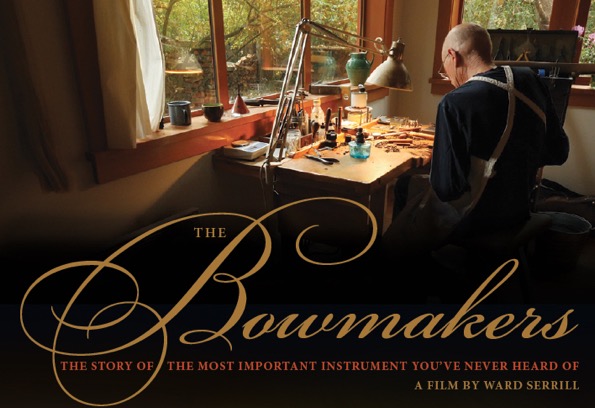
Virtual screenings are game changers! They empower independent filmmakers to do the impossible:
No distributors are required.
Virtual screenings are pandemic proof.
I define virtual screenings as events presented online to a physically dispersed audience – a film can be made privately available to members of a single organization or it can be made publicly available to a global audience.
This Bulletin is a one-of-a-kind guide to virtual screenings. My client, Ward Serrill, is a very experienced and talented filmmaker. When the release of his documentary The Bowmakers was halted by Covid-19, he became an entrepreneur on the virtual frontier. He quickly developed deep expertise in presenting successful virtual screenings with partners.
This step-by-step guide is invaluable. Whether you have started doing virtual screenings, are planning them, or are just learning about them, this Bulletin provides the nuts-and-bolts information you need. Don’t proceed without reading it first.
I want to thank Ward for all the time and effort he spent to create this guide and for his generosity in sharing his hard-won knowledge with everyone. I trust his example will inspire others to share what they learn, enabling independent filmmakers to collectively thrive in the unprecedented virtual future.
-Peter Broderick
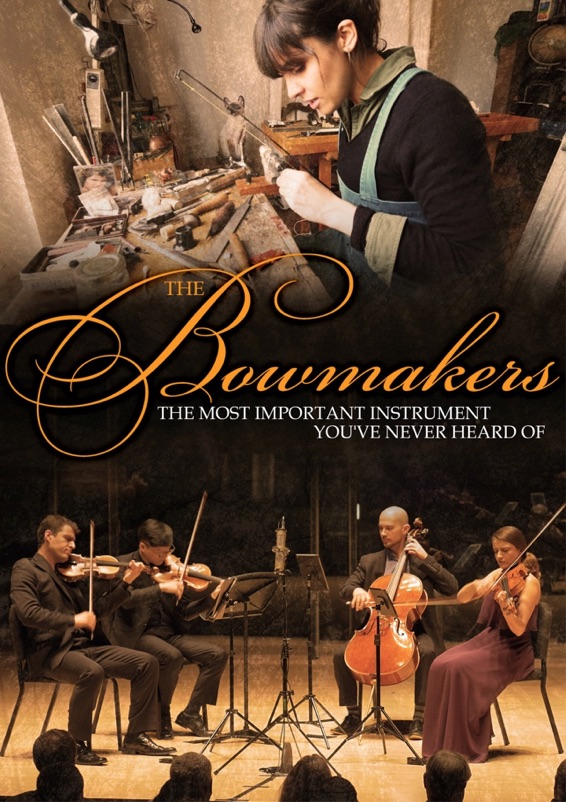
VIRTUAL SCREENINGS:
A Step-by-Step Guide
By Ward Serrill
I had just completed my latest film, The Bowmakers, about “the most important instrument you’ve never heard of.” It explores the world of the bow and the extraordinary masters who make them.
We were in the fifth week of a strong opening theatrical run, with upwards of 75% capacity at all screenings, when Covid-19 shut us down. As we waited for the smoke to clear, it became apparent that our theatrical run was over for good.
What to do? We knew we had a film that audiences were embracing, with some people coming to it two or three times. Like filmmakers around the world, we faced an uncertain future with no way to get our film to its audience.
We developed a new vision of our release with the help of Show&Tell, a start-up dedicated to enabling filmmakers to do virtual screenings. We decided to present online screening events in partnership with music organizations around the country. These events would enable us to create revenue for the film as well as for orchestras and symphonies struggling with the economic challenges of Covid-19.
See our current virtual screening event with Illinois Philharmonic Orchestra here.
We were challenged by a steep learning curve. Over nine months, we learned many valuable lessons on the frontier of the New World of Distribution. Here is our step-by-step guide to creating successful online screening events.
1. THE IDEA
A. We designed a win-win model that enabled:
B. The partner organization hosts a screening, which runs for a week to ten days. The economics are:
Lesson Learned:
In order to reduce or eliminate the burden of the $3,000 upfront cost to the organization, we encourage them to ask sponsors or key donors to cover this cost. Some organizations raised half the $3,000 from sponsors and some raised the entire amount. Others didn’t try this approach.
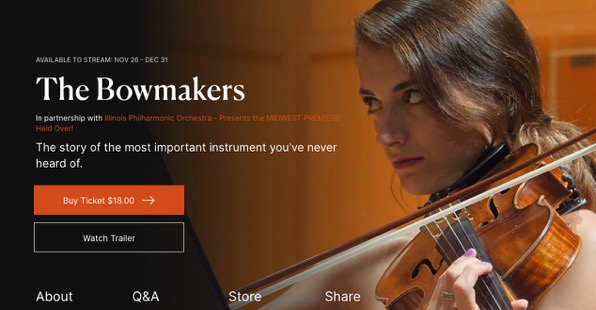
Homepage of current virtual event with Illinois Philharmonic Orchestra. Credit: Ward Serrill
2. IDENTIFYING OUR TARGET PARTNERS
A. While I always hope my films will appeal to a general audience, I have learned that it is essential to first target core audiences. During our five-week theater run, we learned which groups the film appealed to most strongly.
The core audiences we identified are:
B. One of my teammates focused on identifying possible partners across the country whose core audiences matched ours. She compiled a database of symphonies, orchestras, chamber music groups, music conservatories, and chamber music festivals organized by region.
C. By looking at each organization’s reach, sponsors, and donor levels, we identified 140 nationwide to pitch our virtual event to.
D. We drilled down to find the right person or team in each organization. This usually was the development director or the CEO.
Screenshot of our spreadsheet of potential organizations:

Here is a link to the above Google Doc:
https://bit.ly/3lMDitj
Lessons Learned:
1. We discovered Rocket Reach, a great app to help locate email addresses for key personnel in organizations (as well as individuals not part of organizations).
2. We recommend targeting two or more contacts in each organization. Since during the pandemic many people are working from home, have been furloughed, or have had their hours reduced, give yourself multiple chances that someone in the organization will take notice. If the Development Director misses it, maybe the CEO will see it and think it’s a great idea.
3. OUTREACH TO POTENTIAL PARTNERS
A. I developed an email to put our best foot forward. It included a teaser about the virtual event and the film’s trailer.
Here is the email we sent out that included a visual header:
=======================================
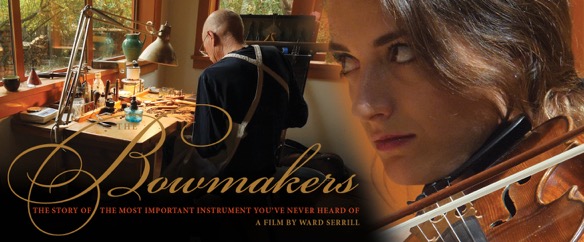
Dear XXX,
THE BOWMAKERS is a new, feature-length documentary that explores the world of the bow and the extraordinary masters who make them. It is a film about music and the innate human impulse to create beauty.
We are partnering with classical music organizations around the country in presenting virtual screenings as a powerful way to engage audiences and a source of new fundraising.
Is there a good time for us to talk about a virtual screening event for your organization?
I look forward to hearing from you soon.
Watch the Trailer!
Sincerely,
Ward Serrill
Writer/Director
Woody Creek Pictures
www.woodycreekpictures.com
"Anyone who loves music, who loves art, who loves craft will appreciate this lovely, illuminating film.” —Nicholas Kazan, Screenwriter
=======================================
B. We initially sent emails to 140 organizations. 10 responded.
Lessons Learned:
1. Send follow-up emails to the organizations that don’t respond.
2. The best way to engage organizations that do respond is calling the contact and doing a short phone pitch (or leaving a message) and then following up with the email.
3. We let people on our mailing list know about our plans to hold virtual screening events. We asked them to share contacts they knew in music organizations and then reached out to them.
4. When we got more events under our belts, we asked the heads of our partner organizations to suggest contacts we could approach at other organizations.
4. PITCHING THE SCREENING
A. We initially pitched to the ten organizations that responded. Working closely with Show&Tell, we developed a persuasive template for a virtual event site.
B. We did all pitch sessions via Zoom. Sharing my screen with the organization’s team, we walked them through what their screening site would look like and how it would function.
C. Our pitch went like this:
D. These Zoom calls lasted no more than 30 minutes.
E. We got seven confirmed events from our initial ten pitch sessions. Right off the bat, we had $21,000 (7 x $3,000) in the bank, plus our 50% of ticket sales to come and additional revenue from sales of our DVD and downloads of the film.
Lesson Learned:
Organizations which may be interested respond first with questions over email. These usually have to do with cost. We learned not to respond to these questions via email, instead suggesting, “Let’s set up a Zoom call so we can show you the model and answer all those questions.”

Bowmaker Stephane Thomachot in France, sighting a bow. Photo: Ward Serrill
5. SECURING THE SALE
After an organization has seen the film (via our password protected screener) and decided to do an event, we:
Lessons Learned:
1. After we shared the screener with them, it took patience and follow-up to get them to commit. If they loved the film, we knew we had a good shot. But often other decision makers also had to watch it before there was a final decision.
2. Run your event over two weekends (10 days). Like theatrical releases, you will have the most traffic on weekends.
3. Price point for tickets. Most organizations picked our suggested $15. One tried $30-$35 but sales were much lower than they are for lower priced events. One organization did presales at $15 and changed midstream to $25. As soon as they raised the price, the bottom fell out of ticket sales. We have concluded that $15-18 is tops.
4. Nonprofits are overwrought now; employees have been cut or furloughed from their marketing departments. You must simplify the model for organizations and assure them it is not a big lift marketing wise.
6. EVENT WEBSITE ELEMENTS
The Screening event website should include:
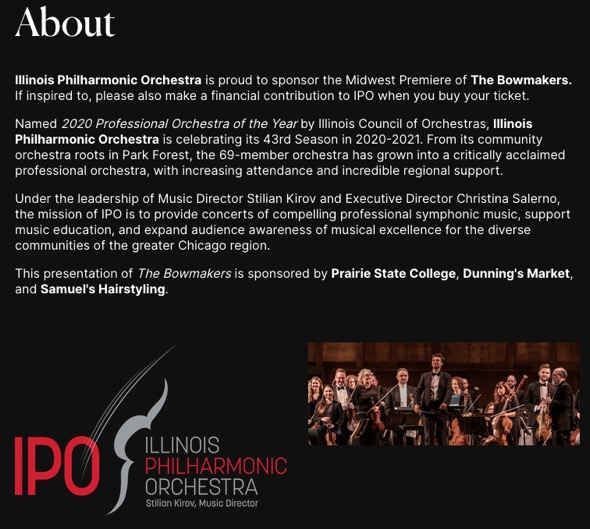
About section of virtual screening website with Illinois Philharmonic Orchestra. Credit: IPO
Lessons Learned:
1. Some organizations may not be prepared to create a short introductory video. Show them samples that other organizations have produced. Offer to create it for them if they can’t do it. They need to provide you with:
2. Live Q&A tip: While the partner organization is responsible for hosting the Zoom live event, you must help them do it well. In most cases, doing a live Webinar is new to them. I coach them on how to set up their screen to produce a good image and proper framing. I provide them a list of possible questions to ask guests. I have them start the Q&A by asking me how I got the idea for the film. I can get the ball rolling and engage the audience right off.
7. MARKETING THE EVENTS
A. For us to succeed, the organization has to succeed. It is their audience we need to connect with. I had to become a marking consultant for the organization. Doing virtual screenings was a first for many of them. Their bread and butter was live music events. They relied on us to learn how to promote a film.
B. Over time, I discovered it was easier for us to create templates for their marketing materials. We shared with them: descriptions of the film, key photographs and poster art, and our design files for creating a flyer for sponsors. We also created draft emails for them to send to potential viewers.
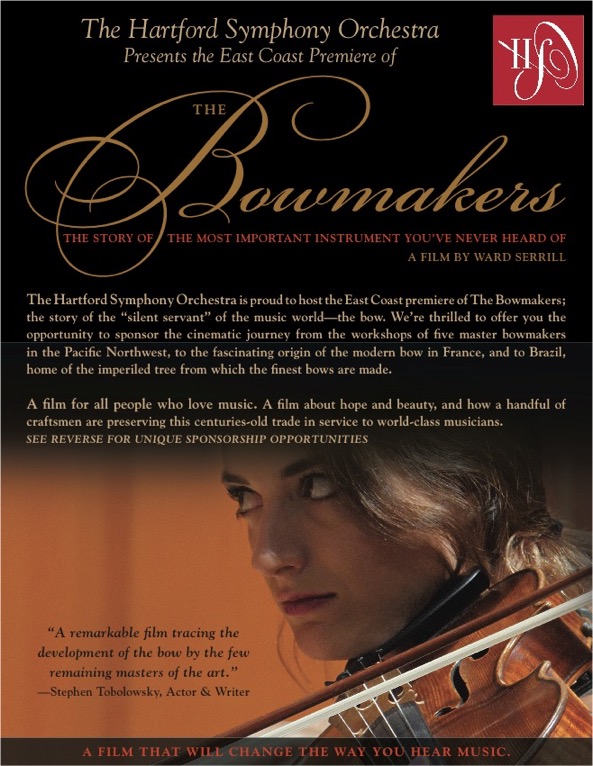
Sponsor Outreach flyer for Hartford Symphony Orchestra. Credit: Ward Serrill
C. Organizations marketed the film by:
Link to article on film and event in Chicago Tribune: https://bit.ly/Chic-Trib
Lessons Learned:
1. We counsel organizations to send three email blasts. The first a few days before the event, the second on opening weekend, and the third just prior to closing weekend emphasizing the Live Q&A event.
2. Offer a Sneak Preview. We are offering our current partner organizations a free 2-4 day sneak preview for their musicians or key influencers before the film is offered live to the public. The Illinois Philharmonic offered the sneak preview free to its 60-member orchestra and then asked them to share the ticketed site with 5 of their friends and colleagues.
8. RESULTS
We have secured partnerships with seven organizations (with two more pending decision).
A. The four events held so far have averaged total revenue between $7,000-$11,000 each, with average ticket sales of 300. Half the viewers also made an added donation to the organization. 10% purchased a DVD or download.
B. Financial returns are not the only measure of success. As a filmmaker at a crossroads (or a wall) when Covid struck, I am now getting my film directly into the living rooms of my target audience.
C. It also feels deeply satisfying to be helping nonprofit organizations now, especially music organizations frozen out from hosting live events. Art heals, and putting beauty to work for good is never more essential than during such challenging times.
Lessons Learned:
1. Marketing a streaming film is hard. There is a bumper crop of streaming content available to audiences right now. From studios releasing directly online to added competition from streaming sites (Netflix, Hulu, Amazon, Disney) to film festivals now entirely online, audiences are awash in content. Your film is unlikely to sell itself. You have to stay at it and work with organizations to get your film in front of their audiences multiple times.
2. Hire a Customer Service Representative. This was our biggest lesson. Any streaming offering will present a host of issues: viewers credit card transactions not working; the film not playing over the multiverse of different browsers and devices (computer, iPad, phone) available, etc. We prepared a set of FAQ’s on the site to help people troubleshoot. We provided them a direct email to our customer service representative, who over time became skilled at resolving customer issues. Issues will come up. Our experience was that 5% of viewers will have problems. You don’t want them contacting the organization to resolve them.
3. Be prepared to have an ongoing working relationship with the staff at the organization. Once you have set up and launched a site, be ready to respond to questions and issues on nearly a daily basis. Eventually you will learn responses and quick workarounds for any issues that arise.
4. Ticketed events are not the only way to go. If an organization just wants to present your film to their audience, you can charge them an overall screening fee and then allow them to offer it free to their audience during the screening period.
5. Keep learning, keep growing. Even today as of this writing, I’ve been in touch with the good folks at Show&Tell with another idea to make their site work better for the organizations and the viewers.
Initially, I resisted the move toward virtual screenings, only forced into them by the pandemic. But since embracing them and becoming more entrepreneurial minded as a filmmaker, I now see them as a centerpiece of any film distribution strategy I’ll have in the future. Virtual screenings enable me to connect directly with my target audience and to bring in respectable cash flow. They have also given me a special opportunity to meaningfully interact with viewers remotely.

Credit: Woody Creek Pictures
Ward Serrill is the award-winning director of The Heart of the Game, released by Miramax to wide critical acclaim. His third full length documentary The Bowmakers is now in release. He is currently at work on his fourth, Dancing with the Dead: The Life and Times of Red Pine. https://woodycreekpictures.com/
==============================
Additional Resources
My partner Keith Ochwat is presenting weekly webinars on virtual screening tactics via Show&Tell’s website.
My recent Distribution Bulletins highlighted the breakthrough virtual successes of Five Seasons and The Great 14th.
© 2020 Peter Broderick

Virtual screenings are game changers! They empower independent filmmakers to do the impossible:
- to reach widespread audiences directly
- to exponentially increase awareness of their films
- to generate substantial revenue rapidly
- to enable their films to go viral quickly
- to retain control of their distribution
No distributors are required.
Virtual screenings are pandemic proof.
I define virtual screenings as events presented online to a physically dispersed audience – a film can be made privately available to members of a single organization or it can be made publicly available to a global audience.
This Bulletin is a one-of-a-kind guide to virtual screenings. My client, Ward Serrill, is a very experienced and talented filmmaker. When the release of his documentary The Bowmakers was halted by Covid-19, he became an entrepreneur on the virtual frontier. He quickly developed deep expertise in presenting successful virtual screenings with partners.
This step-by-step guide is invaluable. Whether you have started doing virtual screenings, are planning them, or are just learning about them, this Bulletin provides the nuts-and-bolts information you need. Don’t proceed without reading it first.
I want to thank Ward for all the time and effort he spent to create this guide and for his generosity in sharing his hard-won knowledge with everyone. I trust his example will inspire others to share what they learn, enabling independent filmmakers to collectively thrive in the unprecedented virtual future.
-Peter Broderick

VIRTUAL SCREENINGS:
A Step-by-Step Guide
By Ward Serrill
I had just completed my latest film, The Bowmakers, about “the most important instrument you’ve never heard of.” It explores the world of the bow and the extraordinary masters who make them.
We were in the fifth week of a strong opening theatrical run, with upwards of 75% capacity at all screenings, when Covid-19 shut us down. As we waited for the smoke to clear, it became apparent that our theatrical run was over for good.
What to do? We knew we had a film that audiences were embracing, with some people coming to it two or three times. Like filmmakers around the world, we faced an uncertain future with no way to get our film to its audience.
We developed a new vision of our release with the help of Show&Tell, a start-up dedicated to enabling filmmakers to do virtual screenings. We decided to present online screening events in partnership with music organizations around the country. These events would enable us to create revenue for the film as well as for orchestras and symphonies struggling with the economic challenges of Covid-19.
See our current virtual screening event with Illinois Philharmonic Orchestra here.
We were challenged by a steep learning curve. Over nine months, we learned many valuable lessons on the frontier of the New World of Distribution. Here is our step-by-step guide to creating successful online screening events.
1. THE IDEA
A. We designed a win-win model that enabled:
- the symphony or organization to benefit economically and stay connected to their audience.
- us to get our film directly to its target market and generate revenue from each event.
B. The partner organization hosts a screening, which runs for a week to ten days. The economics are:
- $3,000 fee paid to us upfront
- 50/50 split of ticket sales
- 100% of additional donations go to the host organization. (Ticket buyers have the option to add a donation to their ticket purchase)
- 100% of sponsorship revenue for event is kept by the host organization.
- 100% of DVD or product sales (offered on the event’s website) go to us.
Lesson Learned:
In order to reduce or eliminate the burden of the $3,000 upfront cost to the organization, we encourage them to ask sponsors or key donors to cover this cost. Some organizations raised half the $3,000 from sponsors and some raised the entire amount. Others didn’t try this approach.

Homepage of current virtual event with Illinois Philharmonic Orchestra. Credit: Ward Serrill
2. IDENTIFYING OUR TARGET PARTNERS
A. While I always hope my films will appeal to a general audience, I have learned that it is essential to first target core audiences. During our five-week theater run, we learned which groups the film appealed to most strongly.
The core audiences we identified are:
- Classical musicians
- Organizations that support or promote classical music
- Classical music fans
- Instrument makers
B. One of my teammates focused on identifying possible partners across the country whose core audiences matched ours. She compiled a database of symphonies, orchestras, chamber music groups, music conservatories, and chamber music festivals organized by region.
C. By looking at each organization’s reach, sponsors, and donor levels, we identified 140 nationwide to pitch our virtual event to.
D. We drilled down to find the right person or team in each organization. This usually was the development director or the CEO.
Screenshot of our spreadsheet of potential organizations:

Here is a link to the above Google Doc:
https://bit.ly/3lMDitj
Lessons Learned:
1. We discovered Rocket Reach, a great app to help locate email addresses for key personnel in organizations (as well as individuals not part of organizations).
2. We recommend targeting two or more contacts in each organization. Since during the pandemic many people are working from home, have been furloughed, or have had their hours reduced, give yourself multiple chances that someone in the organization will take notice. If the Development Director misses it, maybe the CEO will see it and think it’s a great idea.
3. OUTREACH TO POTENTIAL PARTNERS
A. I developed an email to put our best foot forward. It included a teaser about the virtual event and the film’s trailer.
Here is the email we sent out that included a visual header:
=======================================

Dear XXX,
THE BOWMAKERS is a new, feature-length documentary that explores the world of the bow and the extraordinary masters who make them. It is a film about music and the innate human impulse to create beauty.
We are partnering with classical music organizations around the country in presenting virtual screenings as a powerful way to engage audiences and a source of new fundraising.
Is there a good time for us to talk about a virtual screening event for your organization?
I look forward to hearing from you soon.
Watch the Trailer!
Sincerely,
Ward Serrill
Writer/Director
Woody Creek Pictures
www.woodycreekpictures.com
"Anyone who loves music, who loves art, who loves craft will appreciate this lovely, illuminating film.” —Nicholas Kazan, Screenwriter
=======================================
B. We initially sent emails to 140 organizations. 10 responded.
Lessons Learned:
1. Send follow-up emails to the organizations that don’t respond.
2. The best way to engage organizations that do respond is calling the contact and doing a short phone pitch (or leaving a message) and then following up with the email.
3. We let people on our mailing list know about our plans to hold virtual screening events. We asked them to share contacts they knew in music organizations and then reached out to them.
4. When we got more events under our belts, we asked the heads of our partner organizations to suggest contacts we could approach at other organizations.
4. PITCHING THE SCREENING
A. We initially pitched to the ten organizations that responded. Working closely with Show&Tell, we developed a persuasive template for a virtual event site.
B. We did all pitch sessions via Zoom. Sharing my screen with the organization’s team, we walked them through what their screening site would look like and how it would function.
C. Our pitch went like this:
- Introductions
- We are reimagining ourselves as filmmakers and how to get our film out just as you are reimagining your organization and how to stay connected to your audience.
- Our model allows you to host an exclusive screening event specifically for your audience. These ticketed events can run a week, ten days, or as long as you want.
- We explained the three ways they can make money:
- A 50/50 split of ticket sales
- 100% of added donations
- Additional sponsorship revenue
- We shared our screen and walked them through the site.
- We answered any questions.
- Finally, we said that we wouldn’t expect a decision without them first seeing the film. We followed up by providing their decision makers with a password protected link to the film.
D. These Zoom calls lasted no more than 30 minutes.
E. We got seven confirmed events from our initial ten pitch sessions. Right off the bat, we had $21,000 (7 x $3,000) in the bank, plus our 50% of ticket sales to come and additional revenue from sales of our DVD and downloads of the film.
Lesson Learned:
Organizations which may be interested respond first with questions over email. These usually have to do with cost. We learned not to respond to these questions via email, instead suggesting, “Let’s set up a Zoom call so we can show you the model and answer all those questions.”

Bowmaker Stephane Thomachot in France, sighting a bow. Photo: Ward Serrill
5. SECURING THE SALE
After an organization has seen the film (via our password protected screener) and decided to do an event, we:
- Worked with them to secure dates for the screening.
- Helped them decide on a price for the event.
- Explained what marketing materials we will need from them and when we needed them. These materials were: description of the organization, 5-6 high quality photographs, and an introductory video.
- Worked with them to make their event more exclusive by developing a premiere status to use in their marketing (World Virtual Premiere, East Coast Premiere, World Conservatory Premiere, Southwest Premiere, Rocky Mountain Premiere, and Midwest Premiere).
- Sent them a simple Letter of Agreement outlining terms to be signed by the appropriate officer of the organization.
Lessons Learned:
1. After we shared the screener with them, it took patience and follow-up to get them to commit. If they loved the film, we knew we had a good shot. But often other decision makers also had to watch it before there was a final decision.
2. Run your event over two weekends (10 days). Like theatrical releases, you will have the most traffic on weekends.
3. Price point for tickets. Most organizations picked our suggested $15. One tried $30-$35 but sales were much lower than they are for lower priced events. One organization did presales at $15 and changed midstream to $25. As soon as they raised the price, the bottom fell out of ticket sales. We have concluded that $15-18 is tops.
4. Nonprofits are overwrought now; employees have been cut or furloughed from their marketing departments. You must simplify the model for organizations and assure them it is not a big lift marketing wise.
6. EVENT WEBSITE ELEMENTS
The Screening event website should include:
- A Home page that features the partner organization
- An “About the Organization” page

About section of virtual screening website with Illinois Philharmonic Orchestra. Credit: IPO
- An introductory 15-45 second video produced by the organization that precedes the film and is seen by all viewers. This video can also feature sponsors.
- Presale tickets so the organization can begin marketing and selling in advance. (The presale price can be at a discount).
- A live Zoom webinar Event with the filmmakers and stars of the film for closing weekend. These events are hosted by the organization and feature a bowmaker, a key musician from the film, and myself. The organization provides the facilitator and additional panelists.
Lessons Learned:
1. Some organizations may not be prepared to create a short introductory video. Show them samples that other organizations have produced. Offer to create it for them if they can’t do it. They need to provide you with:
- An audio of the narration: “XXX organization is proud to present the Midwest premiere of….etc.”
- High resolution photographs
- Organization logo
- Logos or list of any sponsors
- A piece of music
2. Live Q&A tip: While the partner organization is responsible for hosting the Zoom live event, you must help them do it well. In most cases, doing a live Webinar is new to them. I coach them on how to set up their screen to produce a good image and proper framing. I provide them a list of possible questions to ask guests. I have them start the Q&A by asking me how I got the idea for the film. I can get the ball rolling and engage the audience right off.
7. MARKETING THE EVENTS
A. For us to succeed, the organization has to succeed. It is their audience we need to connect with. I had to become a marking consultant for the organization. Doing virtual screenings was a first for many of them. Their bread and butter was live music events. They relied on us to learn how to promote a film.
B. Over time, I discovered it was easier for us to create templates for their marketing materials. We shared with them: descriptions of the film, key photographs and poster art, and our design files for creating a flyer for sponsors. We also created draft emails for them to send to potential viewers.

Sponsor Outreach flyer for Hartford Symphony Orchestra. Credit: Ward Serrill
C. Organizations marketed the film by:
- Posting the event on their website Home page
- Sending emails to their audience list. (Three different ones sent out – see “Lessons Learned” below)
- Getting local print and radio media to cover the event. The Illinois Philharmonic Orchestra was able to get two newspaper reviews of the event, plus have it featured on their local public radio station
- Social media
- Doing dinner-and-a-movie events with local restaurants providing take-out meals
- Getting local schools or educational organizations involved
Link to article on film and event in Chicago Tribune: https://bit.ly/Chic-Trib
Lessons Learned:
1. We counsel organizations to send three email blasts. The first a few days before the event, the second on opening weekend, and the third just prior to closing weekend emphasizing the Live Q&A event.
2. Offer a Sneak Preview. We are offering our current partner organizations a free 2-4 day sneak preview for their musicians or key influencers before the film is offered live to the public. The Illinois Philharmonic offered the sneak preview free to its 60-member orchestra and then asked them to share the ticketed site with 5 of their friends and colleagues.
8. RESULTS
We have secured partnerships with seven organizations (with two more pending decision).
- Seattle Orchestra and Chamber Singers
- Harford Symphony Orchestra
- Curtis Institute of Music
- Illinois Philharmonic Orchestra
- Santa Fe Chamber Music Festival
- Friends of Chamber Music Denver
- Orcas Island Chamber Music Festival
A. The four events held so far have averaged total revenue between $7,000-$11,000 each, with average ticket sales of 300. Half the viewers also made an added donation to the organization. 10% purchased a DVD or download.
B. Financial returns are not the only measure of success. As a filmmaker at a crossroads (or a wall) when Covid struck, I am now getting my film directly into the living rooms of my target audience.
C. It also feels deeply satisfying to be helping nonprofit organizations now, especially music organizations frozen out from hosting live events. Art heals, and putting beauty to work for good is never more essential than during such challenging times.
Lessons Learned:
1. Marketing a streaming film is hard. There is a bumper crop of streaming content available to audiences right now. From studios releasing directly online to added competition from streaming sites (Netflix, Hulu, Amazon, Disney) to film festivals now entirely online, audiences are awash in content. Your film is unlikely to sell itself. You have to stay at it and work with organizations to get your film in front of their audiences multiple times.
2. Hire a Customer Service Representative. This was our biggest lesson. Any streaming offering will present a host of issues: viewers credit card transactions not working; the film not playing over the multiverse of different browsers and devices (computer, iPad, phone) available, etc. We prepared a set of FAQ’s on the site to help people troubleshoot. We provided them a direct email to our customer service representative, who over time became skilled at resolving customer issues. Issues will come up. Our experience was that 5% of viewers will have problems. You don’t want them contacting the organization to resolve them.
3. Be prepared to have an ongoing working relationship with the staff at the organization. Once you have set up and launched a site, be ready to respond to questions and issues on nearly a daily basis. Eventually you will learn responses and quick workarounds for any issues that arise.
4. Ticketed events are not the only way to go. If an organization just wants to present your film to their audience, you can charge them an overall screening fee and then allow them to offer it free to their audience during the screening period.
5. Keep learning, keep growing. Even today as of this writing, I’ve been in touch with the good folks at Show&Tell with another idea to make their site work better for the organizations and the viewers.
Initially, I resisted the move toward virtual screenings, only forced into them by the pandemic. But since embracing them and becoming more entrepreneurial minded as a filmmaker, I now see them as a centerpiece of any film distribution strategy I’ll have in the future. Virtual screenings enable me to connect directly with my target audience and to bring in respectable cash flow. They have also given me a special opportunity to meaningfully interact with viewers remotely.

Credit: Woody Creek Pictures
Ward Serrill is the award-winning director of The Heart of the Game, released by Miramax to wide critical acclaim. His third full length documentary The Bowmakers is now in release. He is currently at work on his fourth, Dancing with the Dead: The Life and Times of Red Pine. https://woodycreekpictures.com/
==============================
Additional Resources
My partner Keith Ochwat is presenting weekly webinars on virtual screening tactics via Show&Tell’s website.
My recent Distribution Bulletins highlighted the breakthrough virtual successes of Five Seasons and The Great 14th.
© 2020 Peter Broderick